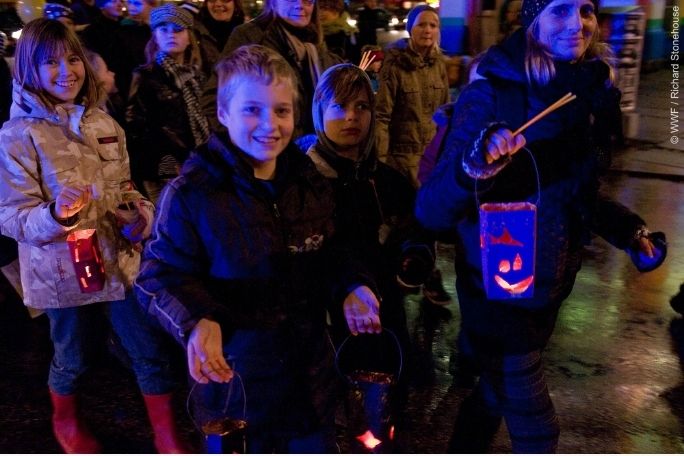Lesson summary
Students begin by sharing what they already know about climate change and the actions we can all take for climate change. They then work as a class to investigate how news article headlines and leading paragraphs are written to draw in the reader. Students will then work in groups to rewrite a range of stories about climate change action in Australia over the past 10 years. Students will then write their own news story and headline to describe an action they are already doing to help fight climate change. This lesson may be followed by Earth Hour – Switch off to join the future – Years 5 & 6 – Lesson 2.
Essential questions:
- What is climate change? What do I already know about climate change?
- How can we limit climate change? What actions can we take? What actions have I already taken?
- What are the roles of the headline and a leading paragraph in a news story? What are the other key components of a news headline?
- What is Earth Hour? How does Earth Hour share messages about climate change and taking action for climate change?
Lesson guides and printables
Lesson details
Curriculum mapping
Australian curriculum content descriptions:
Year 5 English:
- Show how ideas and points of view in texts are conveyed through the use of vocabulary, including idiomatic expressions, objective and subjective language, and that these can change according to context (ACELY1698)
- Identify and explain characteristic text structures and language features used in imaginative, informative and persuasive texts to meet the purpose of the text (ACELY1701)
- Plan, draft and publish imaginative, informative and persuasive print and multimodal texts, choosing text structures, language features, images and sound appropriate to purpose and audience (ACELY1704)
Year 6 English:
- Compare texts including media texts that represent ideas and events in different ways, explaining the effects of the different approaches (ACELY1708)
- Select, navigate and read texts for a range of purposes, applying appropriate text processing strategies and interpreting structural features, for example table of contents, glossary, chapters, headings and subheadings (ACELY1712)
- Plan, draft and publish imaginative, informative and persuasive texts, choosing and experimenting with text structures, language features, images and digital resources appropriate to purpose and audience (ACELY1714)
Syllabus outcomes: EN3-6B, EN3-5B, EN3-2A, EN3-3A.
General capabilities: Literacy, Critical and creative thinking, Personal and social capability.
Cross-curriculum priority: Sustainability OI.1, OI.6.
Relevant parts of Year 5 English achievement standards: Students create imaginative, informative and persuasive texts for different purposes and audiences. When writing, they demonstrate understanding of grammar using a variety of sentence types. They select specific vocabulary and use accurate spelling and punctuation.
Relevant parts of Year 6 English achievement standards: Students understand how language features and language patterns can be used for emphasis, and they create detailed texts elaborating on key ideas for a range of purposes and audiences. They demonstrate an understanding of grammar, and make considered vocabulary choices to enhance cohesion and structure in their writing. Students use accurate spelling and punctuation for clarity.
Unit of work: Earth Hour – Primary.
Time required: 60 mins
Level of teacher scaffolding: High – oversee activity, lead students in creating news pieces.
Resources required
- Student Worksheet – one copy per student OR computers/tablets to access the online worksheet
- Device capable of presenting a website to the class
- Workbooks, pens/pencils
- Earth Hour – Stories from the past 10 years – Years 5 & 6, Inverted pyramid model of journalistic writing, Australia’s kelp forests under threat, robots could be only hope by Margot Kelly.
Skills
This lesson is designed to build students’ competencies in the following skills:
- Communication
- Community engagement
- Creativity
- Digital literacy
- Leadership
- Problem solving
- Social skills
Additional info
This lesson has been created in partnership with WWF-Australia. Earth Hour is the world’s largest community-driven climate change campaign. At the centre of Earth Hour is switching off lights to show a commitment to taking action.
Thousands of teachers use Earth Hour’s education program to enrich their curriculum and provide pathways for young people to create change in their world.
For the most up to date Earth Hour dates, times, and events, check here.


Welcome back!
Don't have an account yet?
Log in with:
By signing up to Cool.org you consent and agree to Cool's privacy policy to
store, manage and process your personal information. To read more, please see
our privacy policy here(Opens in new tab).
Create your free Cool.org account.
Many of our resources are free, with an option to upgrade to Cool+ for premium content.
Already have an account?
Sign up with:
By signing up to Cool.org you consent and agree to Cool's privacy policy to
store, manage and process your personal information. To read more, please see
our privacy policy here(Opens in new tab).